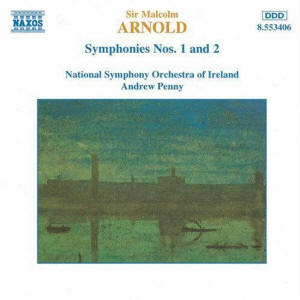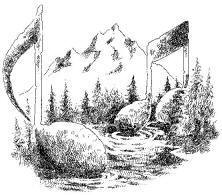|
You are reading the older HTML site
Positive Feedback ISSUE 51
Arnold Symphonies: No. 1, Op. 22; No. 2, Op. 40,
National Symphony Orchestra of Ireland/Andrew Penny.
Naxos 8.553486. TT: 55:41.
If you think of Malcolm Arnold as an agreeable "Pops"-type composer, prepare to be surprised. Arnold's symphonies are tonal and accessible—for which they will immediately be dismissed as "retrograde" in some quarters—but their aesthetic is craggy and angular. The themes aren't the catchy tunes of the various sets of "ethnic" dances (English, Scottish, Cornish), but terse rhythmic motifs capable of full-scale symphonic development. The deployment of the orchestra is colorful, but textures can be light, even sparse, not always lush and full in the Romantic manner. The three-movement First Symphony is perhaps not the best entrée to Arnold's symphonies. Neither of the earlier recordings, led by Richard Hickox (Chandos) and by the composer himself (EMI, in the British Composers series), rendered the score as more than an arid, gnarly, collection of disjunctive episodes (and Arnold's own take is presumably authoritative!). Andrew Penny, at least, makes more sense of it, bringing out an unexpected kinship with Nielsen—the Inextinguishable in the outer movements' obsessive ostinatos, the Sinfonia semplice in the wispy fragments of the central Andantino—while shaping the first movement's quieter, contrasting passages in a way that builds anticipation. There are dry patches, to be sure—by the end, there hasn't been enough sheer musical content to justify a half-hour piece—but Penny manages at least to hold one's interest throughout, which the other recordings didn't. The Second Symphony is an altogether more substantial work, that of a composer of immeasurably greater polish and technical command. The score integrates a variety of audible influences: Nielsen again, in interjections breaking into the first and third movements; Shostakovich in the angular scherzo and the circus-esy, rhythmically irregular finale. It's Sibelius, however, who figures more prominently in the first movement with its folk-like clarinet theme; running woodwind scales a bit later suggest that the Nordic chill is beginning to thaw. The rhythms of the scherzo are buoyant. The lighter-textured slow movement's haunting, searching lines sound in a voice that's uniquely Arnold's; a grim march intrudes at 5:26, returning to cast a quiet shadow over the movement's close. In the finale, the working-out of the threatening second theme, introduced by unison horns, in successive fugal entries by trumpets, trombones, and low strings is a distinctive touch. The engineering is excellent: there's plenty of space around the sound—the more lightly scored passages are deliciously clean and airy—and the solo woodwinds in particular have a nice depth and an almost tactile presence. The contrast with the cluttered, noisy Chandos recording of Op. 22 could not be clearer.
|


